西安电子科技大学:《神经网络与模糊系统 Neural Networks and Fuzzy Systems》课程PPT课件讲稿(2006)Chapter 03-2 NEURONAL DYNAMICS 2:ACTIVATION MODELS
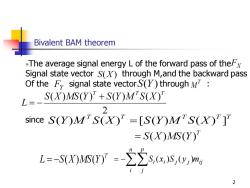
Bivalent BAM theorem -The average signal energy L of the forward pass of theFx Signal state vector S(X)through M,and the backward pass Of the Fy signal state vectorS(Y)through M?: L=一 S(X)MS(Y)+S(Y)M'S(X) 2 since S(M'S(X)=[S(MS(X) =S(X)MS(Y) L=-SX)MSY)y=-∑∑S(x,)S,Oy,m 2
2 Bivalent BAM theorem The average signal energy L of the forward pass of the Signal state vector through M,and the backward pass Of the signal state vector through : FX S(X) T FY S(Y) M 2 ( ) ( ) ( ) ( ) T T T S X MS Y S Y M S X L + = − T T T T T S(Y)M S(X) =[S(Y)M S(X) ] T = S(X)MS(Y) since T L = −S(X)MS(Y) i j n i p j = −Si (xi )S j ( y j )m

Lower bound of Lyapunov function -The signal energy Lyapunov function is clearly bounded below. For binary or bipolar,the matrix coefficients define the attainable bound:L≥-∑∑m,l i -The attainable upper bound is the negative of this expression. 3
3 Lower bound of Lyapunov function The signal energy Lyapunov function is clearly bounded below. For binary or bipolar,the matrix coefficients define the attainable bound: The attainable upper bound is the negative of this expression. − i j L mij

Lyapunov function for the general BAM system -The signal-energy Lyapunov function for the general BAM system takes the form L=-S(X)MS(Y)"-S(X)I-U-S(Y)J- Inputs I=[i,…,Iv]andJ=[Ui,…,Jp]and constant vectors of thresholds U=[U,,Ux]V=[V,,V] the attainable bound of this function is. ≥∑∑m∑-l-∑,-h 4
4 Lyapunov function for the general BAM system The signal-energy Lyapunov function for the general BAM system takes the form Inputs and and constant vectors of thresholds the attainable bound of this function is. T T T L = −S(X)MS(Y) − S(X) [I −U] − S(Y) [J −V] [ , , ] N I I I = 1 [ , , ] P J J J = 1 [ , , ] U U1 UN = [ , , ] V V1 VN = − − − − − j j j i i i i j L mi j [ I U ] [ J V ]
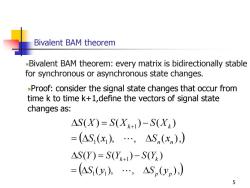
Bivalent BAM theorem -Bivalent BAM theorem:every matrix is bidirectionally stable for synchronous or asynchronous state changes. Proof:consider the signal state changes that occur from time k to time k+1,define the vectors of signal state changes as: △S(X)=S(Xk+1)-S(Xk) =(AS(x)2…,ASn(xn),) AS(Y)=S(Y)-S(Y) =AS(y)2…,S,yp),) 5
5 Bivalent BAM theorem Bivalent BAM theorem: every matrix is bidirectionally stable for synchronous or asynchronous state changes. Proof: consider the signal state changes that occur from time k to time k+1,define the vectors of signal state changes as: ( ( ), , ( ),) ( ) ( ) ( ) 1 1 1 n n k k S x S x S X S X S X = = + − ( ( ), , ( ),) ( ) ( ) ( ) 1 1 1 p p k k S y S y S Y S Y S Y = = + −
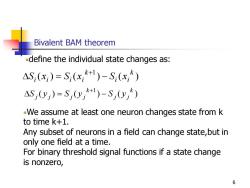
Bivalent BAM theorem -define the individual state changes as: △S,(x)=S,(x,+l)-S,(x;) AS,(y,)=S,y,)-S,(y,) -We assume at least one neuron changes state from k to time k+1. Any subset of neurons in a field can change state,but in only one field at a time. For binary threshold signal functions if a state change is nonzero, 6
6 Bivalent BAM theorem define the individual state changes as: ( ) ( ) ( ) k i i k i i i i S x = S x − S x +1 ( ) ( ) ( ) k j j k j j j j S y = S y − S y +1 We assume at least one neuron changes state from k to time k+1. Any subset of neurons in a field can change state,but in only one field at a time. For binary threshold signal functions if a state change is nonzero

Bivalent BAM theorem △S,(x)=1-0=1△S,(x;)=0-1=-1 For bipolar threshold signal functions AS,(x)=2 AS,(x;)=-2 The“energy'change△L △L=Lk+1-Lk Differs from zero because of changes in field Fy or in field Fy 7
7 Bivalent BAM theorem Si (xi ) = 1− 0 = 1 ( ) = 0 −1 = −1 i i S x Si (xi ) = 2 Si (xi ) = −2 For bipolar threshold signal functions The “energy”change L L = Lk+1 − Lk Differs from zero because of changes in field or in field FX FY

Bivalent BAM theorem △L=-△S(X)MS(Yk)'-△S(X)[I-U] =-AS(X)IS(Y)M-U =-∑∑AS,(,)S,0y)m∑AS,(x)山,+∑AS,(x,U -∑As,(G∑S0ym,-∑aSx川,+∑As, =-∑AS,(x)∑S,)m,+1,-U] =-AS,(x,Ix41-U月 8
8 Bivalent BAM theorem T T L = −S(X)MS(Yk ) − S(X) [I −U] T T = −S(X)[S(Yk )M −[I −U]] = − − + i i i i i i i i i j i j k T Si xi S j y m S x I S x U j ( ) ( ) ( ) ( ) = − − + i i i i i i i i i j i j k T Si xi S j y m S x I S x U j ( ) ( ) ( ) ( ) ( )[ ( ) ] i i i j i j k T Si xi S j y m I U j = − + − ( )[ ]i i k = −Si xi xi −U +1 0
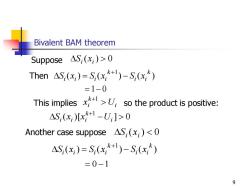
Bivalent BAM theorem Suppose AS;(x;)>0 Then AS;(x)=S;()-S;(x) =1-0 This implies so the product is positive: △S,(x,)[x+1-U,]>0 Another case suppose AS;(x;)<0 △S,(x)=S,(x,k+1)-S,(x,) =0-1 9
9 Bivalent BAM theorem Suppose Si (xi ) 0 ( ) ( ) ( ) k i i k i i i i S x = S x − S x +1 = 1− 0 Then This implies so the product is positive: i k xi U +1 0 1 − + ( )[ ] i k Si xi xi U Another case suppose Si (xi ) 0 ( ) ( ) ( ) k i i k i i i i S x = S x − S x +1 = 0 −1
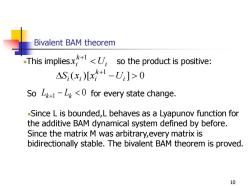
Bivalent BAM theorem -This impliesxUs so the product is positive: AS,(x)[x+1-U,>0 So+-Lk<0 for every state change. -Since L is bounded,L behaves as a Lyapunov function for the additive BAM dynamical system defined by before. Since the matrix M was arbitrary,every matrix is bidirectionally stable.The bivalent BAM theorem is proved. 10
10 Bivalent BAM theorem This implies so the product is positive: i k xi U +1 0 1 − + ( )[ ] i k Si xi xi U So for every state change. 0 Lk+1 − Lk Since L is bounded,L behaves as a Lyapunov function for the additive BAM dynamical system defined by before. Since the matrix M was arbitrary,every matrix is bidirectionally stable. The bivalent BAM theorem is proved
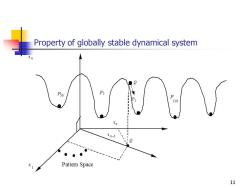
Property of globally stable dynamical system 56 P2 110 Xn-1 Pattern Space 11
11 Property of globally stable dynamical system
按次数下载不扣除下载券;
注册用户24小时内重复下载只扣除一次;
顺序:VIP每日次数-->可用次数-->下载券;
- 西安电子科技大学:《神经网络与模糊系统 Neural Networks and Fuzzy Systems》课程PPT课件讲稿(2006)Chapter 03-1 NEURONAL DYNAMICS 2:ACTIVATION MODELS.ppt
- 西安电子科技大学:《神经网络与模糊系统 Neural Networks and Fuzzy Systems》课程PPT课件讲稿(2006)Chapter 02 NEURAL DYNAMIC1:ACTIVATIONHS AND SIGNALS(主讲:高新波).ppt
- 西安电子科技大学:《神经网络与模糊系统 Neural Networks and Fuzzy Systems》课程PPT课件讲稿(2004)Chapter 09-1 模糊与神经网络倒车系统比较.ppt
- 西安电子科技大学:《神经网络与模糊系统 Neural Networks and Fuzzy Systems》课程PPT课件讲稿(2004)Chapter 11 模糊与卡尔曼滤波目标跟踪控制系统的比较 Comparison of Fuzzy and Kalman-Filter Target-Tracking control system.ppt
- 西安电子科技大学:《神经网络与模糊系统 Neural Networks and Fuzzy Systems》课程PPT课件讲稿(2004)Chapter 09-2 模糊倒车控制系统——拖斗拖车.ppt
- 西安电子科技大学:《神经网络与模糊系统 Neural Networks and Fuzzy Systems》课程PPT课件讲稿(2004)Chapter 08-2 Fuzzy Associative Memories 模糊联想记忆 FUZZY ASSOCIATIVE MEMMORIESⅡ.ppt
- 西安电子科技大学:《神经网络与模糊系统 Neural Networks and Fuzzy Systems》课程PPT课件讲稿(2004)Chapter 10 模糊图像变换编码.ppt
- 西安电子科技大学:《神经网络与模糊系统 Neural Networks and Fuzzy Systems》课程PPT课件讲稿(2004)Chapter 08-1 Fuzzy Associative Memories.ppt
- 西安电子科技大学:《神经网络与模糊系统 Neural Networks and Fuzzy Systems》课程PPT课件讲稿(2004)Chapter 07-2 Fuzziness vs. Probability 模糊集合的模糊程度——模糊熵.ppt
- 西安电子科技大学:《神经网络与模糊系统 Neural Networks and Fuzzy Systems》课程PPT课件讲稿(2004)Chapter 07-1 Fuzziness vs. Probability.ppt
- 西安电子科技大学:《神经网络与模糊系统 Neural Networks and Fuzzy Systems》课程PPT课件讲稿(2004)Chapter 06 Architecture and Equilibra 结构和平衡.ppt
- 西安电子科技大学:《神经网络与模糊系统 Neural Networks and Fuzzy Systems》课程PPT课件讲稿(2004)Chapter 05-2 Synaptic DynamicsII:Supervised Learning.ppt
- 西安电子科技大学:《神经网络与模糊系统 Neural Networks and Fuzzy Systems》课程PPT课件讲稿(2004)Chapter 05-1 第五章 突触动力学Ⅱ:有监督学习.ppt
- 西安电子科技大学:《神经网络与模糊系统 Neural Networks and Fuzzy Systems》课程PPT课件讲稿(2004)Chapter 04 SYNAPTIC DYNAMICS 1:UNSUPERVISED LEARNING.ppt
- 西安电子科技大学:《神经网络与模糊系统 Neural Networks and Fuzzy Systems》课程PPT课件讲稿(2004)Chapter 03 Neuronal Dynamics 2:Activation Models.ppt
- 西安电子科技大学:《神经网络与模糊系统 Neural Networks and Fuzzy Systems》课程PPT课件讲稿(2004)Chapter 02 ACTIVATIONS AND SIGNALS.ppt
- 西安电子科技大学:《神经网络与模糊系统 Neural Networks and Fuzzy Systems》课程PPT课件讲稿(2003)10. 模糊与卡尔曼滤波目标跟踪控制系统的比较 Comparison of Fuzzy and Kalman-Filter Target-Tracking Control Systems.ppt
- 西安电子科技大学:《神经网络与模糊系统 Neural Networks and Fuzzy Systems》课程PPT课件讲稿(2003)09. 模糊图像变换编码 Fuzzy Image Transform Coding.ppt
- 西安电子科技大学:《神经网络与模糊系统 Neural Networks and Fuzzy Systems》课程PPT课件讲稿(2003)08. 模糊与神经网络的比较——以倒车系统为例 Comparison of Fuzzy and Neural Truck Backer-Upper Control Systems.ppt
- 西安电子科技大学:《神经网络与模糊系统 Neural Networks and Fuzzy Systems》课程PPT课件讲稿(2003)07. 模糊联想记忆 Fuzzy Associative Memories(FAM).ppt
- 西安电子科技大学:《神经网络与模糊系统 Neural Networks and Fuzzy Systems》课程PPT课件讲稿(2006)Chapter 04-1 Synaptic Dynamics:Unsupervised Learning Part Ⅰ.ppt
- 西安电子科技大学:《神经网络与模糊系统 Neural Networks and Fuzzy Systems》课程PPT课件讲稿(2006)Chapter 04-2 Synaptic Dynamics:Unsupervised Learning Part Ⅱ.ppt
- 西安电子科技大学:《神经网络与模糊系统 Neural Networks and Fuzzy Systems》课程PPT课件讲稿(2006)Chapter 04-3 Part3 Differential Heb learning & Differential Competitive learning.ppt
- 西安电子科技大学:《神经网络与模糊系统 Neural Networks and Fuzzy Systems》课程PPT课件讲稿(2006)Chapter 05-1 突触动力学Ⅱ——有监督学习.ppt
- 西安电子科技大学:《神经网络与模糊系统 Neural Networks and Fuzzy Systems》课程PPT课件讲稿(2006)Chapter 05-2 Backpropagation Algorithm.ppt
- 西安电子科技大学:《神经网络与模糊系统 Neural Networks and Fuzzy Systems》课程PPT课件讲稿(2006)Chapter 10 模糊图像变换编码.ppt
- 西安电子科技大学:《神经网络与模糊系统 Neural Networks and Fuzzy Systems》课程PPT课件讲稿(2006)Chapter 05-3 突触动力学Ⅱ:有监督的学习.ppt
- 西安电子科技大学:《神经网络与模糊系统 Neural Networks and Fuzzy Systems》课程PPT课件讲稿(2006)Chapter 06 Architecture and Equilibria 结构和平衡.ppt
- 西安电子科技大学:《神经网络与模糊系统 Neural Networks and Fuzzy Systems》课程PPT课件讲稿(2006)Chapter 07-1 模糊与概率(一).ppt
- 西安电子科技大学:《神经网络与模糊系统 Neural Networks and Fuzzy Systems》课程PPT课件讲稿(2006)Chapter 07-2 模糊与概率(二).ppt
- 西安电子科技大学:《神经网络与模糊系统 Neural Networks and Fuzzy Systems》课程PPT课件讲稿(2006)Chapter 08-1 Fuzzy Associative Memories(1/3).ppt
- 西安电子科技大学:《神经网络与模糊系统 Neural Networks and Fuzzy Systems》课程PPT课件讲稿(2006)Chapter 08-2 Fuzzy Associative Memories(2/3).ppt
- 西安电子科技大学:《神经网络与模糊系统 Neural Networks and Fuzzy Systems》课程PPT课件讲稿(2006)Chapter 08-3 Fuzzy Associative Memories(3/3).ppt
- 西安电子科技大学:《神经网络与模糊系统 Neural Networks and Fuzzy Systems》课程PPT课件讲稿(2006)Chapter 11 模糊与卡尔曼滤波目标跟踪控制系统的比较 Comparison of Fuzzy and Kalman-Filter Target-Tracking control system.ppt
- 西安电子科技大学:《神经网络与模糊系统 Neural Networks and Fuzzy Systems》课程PPT课件讲稿(2006)Chapter 09 模糊与神经网络的比较——以倒车系统为例.ppt
- 西安电子科技大学:《神经网络与模糊系统 Neural Networks and Fuzzy Systems》课程PPT课件讲稿(2003)04. 突触动力学Ⅱ:有监督学习 Synaptic Dynamics II——Supervised Learning(1/2).ppt
- 西安电子科技大学:《模糊理论与模糊系统 Fuzzy Theory and Fuzzy Systems》课程教学资源(课件讲义)第一章 绪论——模糊聚类分析(主讲:高新波).pdf
- 西安电子科技大学:《模糊理论与模糊系统 Fuzzy Theory and Fuzzy Systems》课程教学资源(课件讲义)第二章 模糊理论基础 第一部分 普通集合、模糊集合、分解定理与扩展原理.pdf
- 西安电子科技大学:《模糊理论与模糊系统 Fuzzy Theory and Fuzzy Systems》课程教学资源(课件讲义)第二章 模糊理论基础 第二部分 模糊不确定性度量、模糊集的模糊性度量、模糊事件的概率.pdf
- 西安电子科技大学:《模糊理论与模糊系统 Fuzzy Theory and Fuzzy Systems》课程教学资源(课件讲义)第二章 模糊理论基础 第三部分 模糊数及其扩展运算、模糊关系.pdf
